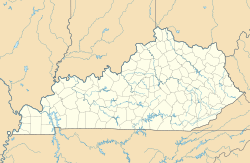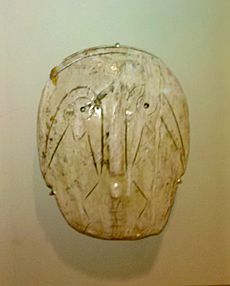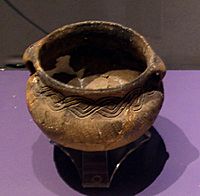Hardin Village site facts for kids
| Location | South Shore, Kentucky, Greenup County, Kentucky, |
|---|---|
| Region | Greenup County, Kentucky |
| Coordinates | 38°44′30.95″N 82°54′53.60″W / 38.7419306°N 82.9148889°W |
| History | |
| Founded | Early AD 1550s |
| Abandoned | AD 1625 |
| Periods | Montour Phase (AD 1550 to 1750) |
| Cultures | Fort Ancient culture |
| Site notes | |
| Excavation dates | 1930s |
The Hardin Village site (also known as 15GP22) was an ancient village built by the Fort Ancient culture. It's an archaeological site located on a flat area next to the Ohio River in Greenup County, Kentucky, near South Shore. This village was part of the Montour Phase of the Fort Ancient people. People lived here starting in the early 1500s, but the village was left empty by 1625. This time period, called protohistory, was when Europeans first arrived in North America. However, by the time European explorers reached this specific area, the Hardin Village had already been abandoned.
Contents
The Hardin Village Site
The Hardin Village site is found on a wide, flat area (a terrace) next to the Ohio River. This terrace is about 2 kilometers (1.2 miles) wide. The village is located a little over 3 miles (4.8 km) from what is now South Shore, Kentucky.
When People Lived There
People lived at Hardin Village from the early 1500s until about 1625. This period is known as the Montour Phase within the Fort Ancient timeline.
Village Size and Layout
During its time, the village covered about 4.5 hectares (11 acres). It stretched about 160 meters (525 feet) from east to west and 300 meters (984 feet) from north to south. Like other Fort Ancient villages, it had a strong wooden fence, called a palisade, built around it for protection.
Unlike many other Fort Ancient villages, Hardin Village didn't have a large, open central area (a plaza). In most Fort Ancient towns, houses faced inward toward this plaza. At Hardin, however, houses seemed to be grouped together in clusters. This might be because new houses were often built in the same spot where older ones had been torn down.
How Houses Were Built
The houses were built using a method called "single set post." This means each wooden post was placed into its own hole in the ground. The rectangular frames were then covered with bark, thatch (like straw), or animal skins. They probably looked similar to the longhouses built by Iroquoian people.
Inside the houses, extra posts helped hold up the roof. Storage pits were dug along the inside walls to keep food and other items. Thin walls divided the large houses into sections for several families. The main doorway was a gap between two larger posts on the side of the house facing the river. Some of these houses were quite big, up to 9.1 meters (30 feet) by 21.5 meters (70.5 feet). The average house size was about 132.9 square meters (1,430 square feet).
Tools and Jewelry of the Fort Ancient People
Just like other groups from that time, the people of Hardin Village used natural materials for their tools and decorations.
Materials Used
- Mussel Shells: Shells from local streams were used to make tools and jewelry.
- Animal Bone and Shell: These were attached to tree limbs to create hoes for gardening.
- Animal Bone: Bones were shaped into useful tools like awls (for piercing holes), punches, fish hooks, needles, and scrapers for preparing animal hides.
- Jewelry: They made beads, hair pins, pendants, tinklers (small objects that make a sound), and decorative shell gorgets (flat, often engraved pieces worn around the neck).
- Gourds and Turtle Shells: Gourds from their gardens and turtle shells were used to make ceremonial rattles for special events.
Pottery Making
The pottery found at Hardin Village is similar to what archaeologists have found at other Fort Ancient sites.
Women were usually the potters. They would add ground mussel shell to wet clay. This shell, called a tempering agent, was kneaded into the clay to make it stronger and less likely to crack when fired. Using ground mussel shell for tempering was a common technique among Mississippian cultures to the south and west. This shows how the Fort Ancient people were influenced by these other cultures.
After preparing the clay, it was rolled into long strips. These strips were then layered and smoothed to create different shapes of pots.
Pottery Decoration
The pottery was decorated in many ways:
- Engraving: Designs were carved into the clay with a sharp stick.
- Cordmarking: Twine was pressed into the wet clay, leaving a textured pattern (cord-marked pottery).
- Stamping and Paddling: Wooden paddles were used to beat or stamp patterns onto the surface.
Most of the pottery found at Hardin Village is called Madisonville-Fox Farm Cordmarked (about 75%). Other common types include Madisonville Plain. Less common types are Fox Farm Saltpan, Madisonville Groove Paddled, Madisonville Net-Impressed, and Fox Farm Check Stamped. These unique decorations and shapes help archaeologists identify Fort Ancient sites, figure out when they were used, and understand which other groups the Fort Ancient people traded with.
Burial Practices
The people of Hardin Village buried their dead in specific areas within the village. Archaeologists have found between 301 and 445 burials at this site. This is the largest number of burials found at any Fort Ancient site in Kentucky.
Types of Burials
Most people were buried in the "extended position," meaning they were laid out straight. A smaller number of burials were found in other positions:
- Flexed position: The body was buried with the knees drawn up.
- Bundle burials: Bones that had been cleaned (excarnated) were gathered and reburied as a bundle.
- Stone slab graves: Some graves were covered with stone slabs.
Grave Goods
About half of the burials included "grave goods," which are items buried with the person. These often included pottery and stone tools. These everyday items were more often buried with adults.
More special or "exotic" items were often buried with children (ages 1 to 4) and adults over about 50. Men were sometimes buried with fancy engraved shell ornaments, hematite (a type of iron ore), and metal objects. These metal items, like brass tubes and copper, came from European sources. These special trade items reached the Fort Ancient people through Mississippian culture groups living to their south and west.
Health of the Fort Ancient People
Studying these burials has taught us about the health of the Fort Ancient people. They were not as healthy as their ancestors who relied less on farming. This was mainly because they depended heavily on growing and eating maize (corn).
Eating a lot of corn without other foods could lead to poor nutrition and a lack of niacin (a vitamin), which caused a disease called pellagra. This diet also led to high rates of arthritis, dental problems, and shorter lives. Many babies also died young. Being poorly nourished also made them more likely to get other infections, such as tuberculosis (though only a few cases were found) and treponematosis, a disease that many people at the site had.
Archaeological Digs
The Hardin Village site has been excavated (dug up by archaeologists) several times. The first digs happened in the late 1930s. More work was done in 1966, and most recently, archaeologists from the University of Kentucky returned to the site in 2015.




